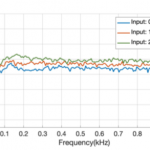 Download available
Download available
Authors:
Aditya Tirumala BukkapatnamPublication or Conference Title:
M.A. Thesis, McGill UniversityAbstract:
Vibrotactile feedback – a type of haptic feedback, is a popular area of research. Aside from widespread applications in video games and mobile phones, vibrotactile feedback is also implemented in Digital Music Instruments (DMIs) to improve the quality of interaction for performers, or as general purpose interfaces for conducting experimental research. Musical interaction is known to involve high cognitive expertise, requiring responsive and highly accurate tools. When implementing such devices, the outputs of the vibrotactile implementations are characterized and equalized. However, these implementations are often “one-of-a-kind”, bulky (>8 kg), expensive (1000$), and impractical to some musical applications, whereas, inexpensive and portable alternatives often lack characterized and equalized outputs. The latter also rely on actuators that cannot display the various types of stimuli that are possible in musical interactions. This study describes the design and implementation of a cost-effective and portable vibrotactile toolkit with a characterized output. The goal of this toolkit is to allow users to prototype and study vibrotactile feedback in musical applications. Many perceptual and technological factors influence the design of vibrotactile systems meant for musical applications. By using these factors as guidelines, suitable actuators, and amplifiers are selected for implementing the toolkit. The outputs of these devices are measured to obtain their magnitude-frequency and harmonic distortion characteristics. In this study, harmonic distortion is characterized by Total Harmonic Distortion (THD) for actuators and Total Harmonic Distortion + Noise (THD+N) for amplifiers. All the tested actuators and amplifiers are found to operate in the full vibrotactile bandwidth (40-1000 Hz). The actuators are measured both when placed on a sandbag (unloaded) as well as when attached to an external sur- face (loaded). The characteristics of the actuator change with loading; Resonant features appear in the frequency response, along with an overall increase in the harmonic distortion. Previously, the resonant characteristics were equalized manually using parametric equalizers. Unlike previous cases, the autoregressive Yule-Walker method is proposed to equalize the resonant characteristics automatically. From the tested actuators and amplifiers, an inexpensive (approximately 200$) and portable (less than 40 g) 2-channel toolkit is implemented. The implemented toolkit is characterized, and the results are presented in a datasheet. Lastly, vibrotactile feedback is implemented in the chassis of an unfinished T-Stick DMI using the toolkit, and its frequency response is automatically equalized using an accelerometer measurement.
Publication Details:
Type: |
Masters Thesis |
Date: |
07/01/2019 |
Pages: |
94 |
Location: |
Montreal, Canada |

